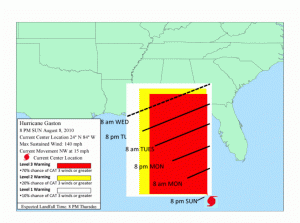TUSCALOOSA, Ala. — When tracking hurricanes, coastal residents often pay strict attention to the “Cone of Uncertainty” – a National Hurricane Center graphic shown on television. The cone shows a probability zone where a hurricane may land and a “through line” displaying the likeliest path. But people often misinterpret what the cone means.
“Some people see a track line going through the middle of the cone, and so people think that’s exactly where the hurricane is going,” says Laura Radford, a graduate student in geography at The University of Alabama. “They don’t understand that the cone represents a probability of error in the forecast. Some people think that if they’re in the cone, they’re definitely going to get hit.”

So a team of undergraduate and graduate students from UA set out to survey people at public events in Pensacola and Jacksonville, Fla., to see how they interpret the “Cones of Uncertainty” and to evaluate different designs that could be easier to interpret.
“Previous research has shown that a large segment of the public is incorrectly interpreting the meaning of this warning graphic,” says Dr. Jason C. Senkbeil, assistant professor of geography and director of the environmental science program.
“Inaccurate interpretation of the warning graphic has led to confusion and chaos during hurricane evacuations.”
One incident in particular involved Hurricane Charley in 2004. When it headed to Tampa, Fla., many residents were confused by the changing forecasts.
“Tampa is in a terrible place for a hurricane,” Radford says. “That forecast actually changed a lot, and so the cone moved a lot. Some people evacuated who didn’t need to, and they were fine, and some people didn’t because of the track line. That was the main issue.”
So Radford and the other students set out to see if people in coastal areas might prefer another form of graphic for the “Cone of Uncertainty.” Radford, who plans to use the collected data for her master’s thesis, and the other students surveyed people at a 5K run and a seafood festival in Pensacola as well as at a Jacksonville Jaguars tailgate area in Jacksonville. They collected about 300 surveys.
The surveys asked participants to rank five different graphic representations of a hurricane’s danger area, including the one currently used. The participants also were asked how much they relied on hurricane graphics to determine if they should evacuate as well as where they lived.
The result: The public preferred one of the alternative graphics. This new graphic was approved across all age groups and by both genders. It uses color in a different way to show people the possibility of danger presented by a hurricane.
“It’s very similar to the cone, but we added color and no track line, Radford says. “It’s a triangle, and it has red in the middle, which is where the highest probably of a direct hit is, then yellow and then white. People respond to color schemes.”
Radford used the research in a student poster presentation at the 33rd Annual Applied Geography Conference in Fort Worth, Texas. The research won first place in the student poster competition. Radford hopes the research will be used to change the way hurricane uncertainty cones are presented to the public.
“I want to work eventually in emergency management, so I want to go into the subject more in-depth, then talk to some people and encourage them to do something different,” she says.
The geography department is part of UA’s College of Arts and Sciences, the University’s largest division and the largest liberal arts college in the state. Students from the College have won numerous national awards including Rhodes Scholarships, Goldwater Scholarships and memberships on the USA Today Academic All American Team.
Contact
Richard LeComte, media relations, rllecomte@ur.ua.edu, 205/348-3782; Dr. Jason C. Senkbeil, 205/348-4942, jcsenkbeil@bama.ua.edu
Dr.